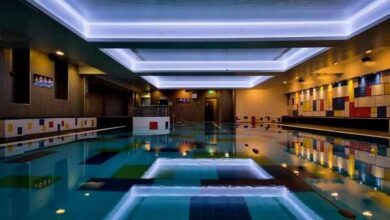When you’re setting up your custom home theater, every detail counts—from screen size to seating arrangements. You might think that picking a large screen is the best choice, but understanding the optimal size for your space is crucial to avoid an overwhelming experience. And while a high-quality projector can elevate your visuals, it’s the sound system that truly immerses you in the action. As you consider these essentials, you’ll find that the layout and comfort of your seating can make or break your home theater experience. What elements should you prioritize next?
Choosing the Right Screen Size
When it comes to choosing the right screen size for your home theater, you want to ensure it complements your space and enhances your viewing experience.
Start by measuring your viewing distance—the ideal distance is typically 1.5 to 2.5 times the screen height. If you’re sitting 10 feet away, a screen height of 60-80 inches is optimal. This range lets you enjoy immersive visuals without straining your eyes.
Consider the room’s layout, too; a larger screen can overwhelm a small space, while a too-small screen can leave viewers squinting. Aim for a balance, keeping in mind the dimensions of both your screen and seating arrangement.
Ultimately, the right size makes all the difference in creating a captivating home theater experience.
Understanding Aspect Ratios
Selecting the right screen size is only part of the equation; understanding aspect ratios is equally important for achieving the best viewing experience.
Aspect ratio types define the relationship between a screen’s width and height, directly impacting your viewing pleasure.
Consider these three key points:
- 16:9 (Widescreen) – The standard for most TVs and films, providing an immersive experience.
- 2.35:1 (CinemaScope) – Ideal for epic films, this ratio enhances the cinematic feel by filling your field of vision.
- 4:3 (Standard) – Once common for older content, it may appear outdated but is still relevant for specific media.
Selecting the Ideal Projector
Finding the ideal projector for your home theater is crucial for elevating your viewing experience.
Start by considering projector brightness; a higher lumen count ensures clarity in various lighting conditions. Next, focus on projector resolution—4K is preferable for stunning image detail.
Pay attention to projector throw; the distance from the projector to the screen affects your image size. Research reputable projector brands known for reliability and performance.
Think about projector placement and mounting options to optimize your setup. Ensure your projector has adequate connectivity options for your devices.
Finally, don’t overlook projector maintenance; regular cleaning and lamp replacement will keep your projector features in top shape.
With these factors in mind, you’ll create a captivating home theater experience.
Sound System Essentials
To truly immerse yourself in a cinematic experience, investing in a high-quality sound system is essential. A well-designed system can make you feel like you’re in the middle of the action.
Here are three key components to consider:
- Surround Sound Speakers: Choose a 5.1 or 7.1 setup to envelop yourself in rich audio, enhancing depth and realism.
- AV Receiver: Select a powerful receiver that supports various audio formats and has multiple HDMI inputs for versatile connectivity.
- Audio Calibration: Use a calibration microphone to fine-tune your system, ensuring optimal sound quality tailored to your space.
Acoustic Treatments for Quality Sound
Even with a top-tier sound system, the quality of your audio can be significantly impacted by the acoustics of your room. To achieve optimal sound, you’ll want to explore various soundproofing techniques and adjust room acoustics.
Start by adding acoustic panels to absorb excess reverberation, reducing echoes that can muddy your audio experience. Bass traps are essential for controlling low frequencies, ensuring a balanced audio profile.
Consider using rugs, heavy curtains, and furniture to further dampen sound waves. Don’t forget about your ceiling—acoustic tiles can enhance sound clarity.
Lighting Considerations for Ambiance
The right lighting can transform your home theater into a captivating cinematic experience. To achieve the perfect ambiance, consider these essential elements:
- Ambient Lighting: Use soft, indirect light to enhance the mood without detracting from the screen.
- Dimmable Options: Install lights with dimmable features to adjust brightness based on your viewing preference.
- Smart Controls: Integrate smart lighting controls for effortless adjustments via your smartphone or voice commands.
Additionally, pay attention to color temperature; warmer tones create a cozy atmosphere.
Strategically place LED strips along walls for subtle highlights, and don’t forget blackout curtains to eliminate outside light, ensuring an immersive viewing experience.
With these considerations, you’ll set the perfect mood for every film night.
Comfortable Seating Options
When it comes to comfortable seating options, choosing the right configuration can enhance your viewing experience significantly.
Think about whether you prefer the luxurious embrace of reclining chairs or the cozy atmosphere of a sofa versus a loveseat.
Each option brings its own unique benefits, so let’s explore what suits your home theater best.
Reclining Chair Choices
A cozy recliner can transform your home theater experience, offering both comfort and support during those lengthy movie marathons.
When choosing the perfect reclining chair, consider these key factors:
- Reclining Styles: Look for options like manual, electric, or wall-hugger designs to fit your space.
- Material Options: Choose from leather, fabric, or microfiber, balancing comfort and durability.
- Adjustable Features: Opt for models with built-in storage, ergonomic designs, and customizable reclining angles for optimal relaxation.
With a wide price range, you can find something that fits your budget.
Don’t forget to check brand comparisons for reliability and maintenance tips to keep your recliner in top shape.
Enjoy the ultimate cinematic experience with the right seating!
Sofa vs. Loveseat
Choosing between a sofa and a loveseat can significantly impact your home theater’s ambiance and comfort.
Sofas typically offer greater sofa durability, accommodating more viewers while providing ample space for lounging. Their larger size allows for a variety of seating arrangements, making them perfect for gatherings.
On the other hand, loveseats, with their compact loveseat dimensions, fit snugly in smaller spaces, creating an intimate viewing experience for couples or small families. They’re ideal if you’re looking to maximize seating while maintaining a cozy atmosphere.
Consider your room size, the number of viewers, and your desired aesthetic when making your choice.
Ultimately, both options can enhance your home theater, but your specific needs will determine the best fit for you.
Layout and Room Design
While the allure of a home theater lies in its immersive experience, achieving the perfect layout and room design is essential to maximizing that enjoyment.
A well-thought-out room flow enhances sound and visual quality, while proper furniture arrangement ensures comfort for all viewers.
Consider these three key elements:
- Screen Positioning: Ensure your screen is at eye level when seated, with no obstructions.
- Seating Configuration: Arrange seats in a staggered format, allowing everyone an unobstructed view while promoting conversation.
- Lighting Control: Incorporate adjustable lighting to create an inviting atmosphere, enhancing both the cinematic experience and the overall design.
Cable Management and Organization
When setting up your home theater, effective cable management is crucial for both aesthetics and functionality.
You’ll want to explore smart storage solutions that not only keep your cables organized but also enhance your viewing experience.
Strategically concealing cables can transform your space into a sleek, distraction-free environment.
Importance of Cable Management
In the realm of home theater systems, effective cable management isn’t just a luxury—it’s a necessity. Proper organization enhances both functionality and aesthetics, ensuring your setup looks as good as it performs.
By considering cable types, lengths, and routing, you can streamline your space and eliminate clutter.
- Cable Safety: Keep cables out of high-traffic areas to prevent tripping hazards.
- Cable Concealment: Use raceways or wall channels to hide unsightly cables, enhancing visual appeal.
- Cable Accessories: Invest in zip ties, sleeves, and clips to maintain organization and prevent tangling.
With thoughtful cable management, you’ll create an efficient and visually pleasing home theater that elevates your viewing experience.
Effective Storage Solutions
How can you maximize your home theater experience through effective storage solutions? Start by choosing appropriate storage types, like media cabinets or wall-mounted shelves, to keep your equipment accessible yet organized.
Consider using drawer organizers for remotes and accessories, preventing clutter and enhancing your viewing area’s aesthetics.
For cables, employ simple organization tips like zip ties or Velcro straps to bundle them neatly. Label each cable to easily identify connections during setup or troubleshooting.
Utilize cable boxes to conceal excess cords while maintaining airflow.
Concealing Cables Strategically
Effective storage solutions set the stage for a clean and organized home theater, but managing the cables is where the real artistry comes into play.
To achieve an impeccable look, consider these strategies:
- Cable Raceways: Use these to hide cables along walls, maintaining clean lines without clutter.
- Decorative Covers: Opt for decorative covers that blend with your decor, ensuring aesthetic integration while concealment.
- Flexible Conduits: These allow for easy re-routing of cables, making adjustments seamless and keeping everything organized.
Additionally, explore wall-mounted conduits and hidden compartments for enhanced organization.
If you want to further reduce cable visibility, wireless alternatives can eliminate the need for unsightly cables altogether, ensuring your home theater remains visually appealing.
Personalizing Your Home Theater
Your home theater’s design isn’t just about the equipment; it’s a canvas for your personal taste and lifestyle.
Consider integrating thematic decor that reflects your favorite films or genres. Use custom colors to create a cohesive look, and add personalized artwork that resonates with your family.
Enhance technology integration by incorporating smart controls for mood lighting, allowing you to set the perfect ambiance. Unique accessories, like vintage elements or acoustic art, can further elevate the space.
Remember, this should be a multifunctional space, encouraging family involvement in movie nights or gaming marathons.
Why You Choose ioty, inc.
IOTY is dedicated to bringing innovation and convenience into homes and businesses through expertly crafted home automation solutions. From immersive home theaters and whole-house audio-video systems to intelligent lighting and climate control, every service is designed to elevate the user experience. The company also provides advanced features like access control, motorized drapery and shades, and cutting-edge surveillance systems, ensuring both functionality and security. Whether working with homeowners, builders, or interior designers, IOTY tailors solutions to meet the unique needs of residential and light-commercial spaces.
Conclusion
In crafting your custom home theater, remember that balance is key: the right screen size enhances your view, a quality projector sharpens your images, and a robust sound system immerses you in audio bliss. Comfortable seating invites you to relax, while thoughtful layout fosters an inviting atmosphere. With meticulous cable management and personal touches, you create a space that reflects your style. Embrace each element, and you’ll transform your room into an extraordinary cinematic escape.





